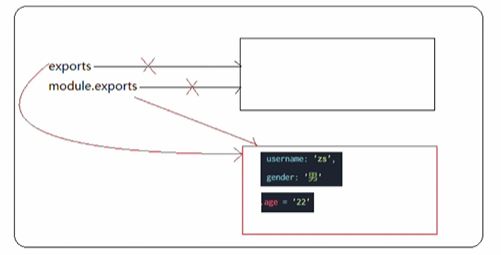本篇文章聊聊node的基礎,關于http模塊及module.exports導出共享的理解和案例,希望對大家有所幫助!

一、http 模塊
http 模塊是 Node.js 官方提供的、用來創建 web 服務器的模塊。
通過 http 模塊提供的 http.createServer() 方法,就能方便的把一臺普通的電腦,變成一臺 web 服務器,從而對外提供 web 資源服務。
1、創建 web 服務器
導入 http 模塊
創建 web 服務器實例
為服務器實例綁定 request 事件,監聽客戶端的請求
啟動服務器
示例:監聽 8080 服務
// 導入 http 模塊
const http = require('http')
// 創建 web 服務器實例
const server = http.createServer()
// 為服務器實例綁定 request 事件 監聽客戶端的請求
server.on('request', function (req, res) {
console.log('請求中...')
})
// 啟動服務
server.listen(8080, function () {
console.log('http://127.0.0.1:8080')
})
2、req 請求對象
只要服務器接收到了客戶端的請求,就會調用通過 server.on() 為服務器綁定的 request 事件處理函數
示例:在事件處理函數中,訪問與客戶端相關的數據或屬性
// 導入 http 模塊
const http = require('http')
// 創建 web 服務器實例
const server = http.createServer()
// req 是請求對象 包含了與客戶端相關的數據和屬性
server.on('request', (req) => {
// req.url 客戶端請求的 url 地址
const url = req.url
// req.method 是客戶端請求的 method 類型
const method = req.method
const str = `Your request url is ${url} and request method is ${method}`
console.log(str)
})
// 啟動服務
server.listen(8080, function () {
console.log('http://127.0.0.1:8080')
})
3、res 響應對象
在服務器的 request 事件處理函數中,如果想訪問與服務器相關的數據或屬性,需要使用 response
示例:請求響應
// 導入 http 模塊
const http = require('http')
// 創建 web 服務器實例
const server = http.createServer()
// req 是請求對象 包含了與客戶端相關的數據和屬性
server.on('request', (req, res) => {
// req.url 客戶端請求的 url 地址
const url = req.url
// req.method 是客戶端請求的 method 類型
const method = req.method
const str = `Your request url is ${url} and request method is ${method}`
console.log(str)
// 調用 res.end() 方法 向客戶端響應一些內容
res.end(str)
})
// 啟動服務
server.listen(8080, function () {
console.log('http://127.0.0.1:8080')
})

4、解決中文亂碼問題
當調用 res.end() 方法,向客戶端發送中文內容時,會出現亂碼問題,需要手動設置內容的編碼格式
示例:解決中文亂碼
// 導入 http 模塊
const http = require('http')
// 創建 web 服務器實例
const server = http.createServer()
// req 是請求對象 包含了與客戶端相關的數據和屬性
server.on('request', (req, res) => {
// req.url 客戶端請求的 url 地址
const url = req.url
// req.method 是客戶端請求的 method 類型
const method = req.method
const str = `請求地址是 ${url} 請求方法是 ${method}`
console.log(str)
// 設置 Content-Type 響應頭 解決中文亂碼問題
res.setHeader('Content-Type', 'text/html; charset=utf-8')
// 調用 res.end() 方法 向客戶端響應一些內容
res.end(str)
})
// 啟動服務
server.listen(8080, function () {
console.log('http://127.0.0.1:8080')
})

5、根據不同的 url 響應不同的 html 內容
示例:步驟如下
獲取請求的 url 地址
設置默認的響應內容為 404 Not found
判斷用戶請求的是否為 / 或 /index.html 首頁
判斷用戶請求的是否為 /about.html 關于頁面
設置 Content-Type 響應頭,防止中文亂碼
使用 res.end() 把內容響應給客戶端
// 導入 http 模塊
const http = require('http')
// 創建 web 服務器實例
const server = http.createServer()
// req 是請求對象 包含了與客戶端相關的數據和屬性
server.on('request', (req, res) => {
// req.url 客戶端請求的 url 地址
const url = req.url
// 設置默認的內容為 404 Not Found
let content = '<h1>404 Not Found!</h1>'
// 用戶請求頁是首頁
if(url === '/' || url === '/index.html') {
content = '<h1>首頁</h1>'
} else if (url === '/about.html') {
content = '<h1>關于頁面</h1>'
}
// 設置 Content-Type 響應頭 防止中文亂碼
res.setHeader('Content-Type', 'text/html; charset=utf-8')
// 調用 res.end() 方法 向客戶端響應一些內容
res.end(content)
})
// 啟動服務
server.listen(8080, function () {
console.log('http://127.0.0.1:8080')
})




二、Node.js 中的模塊分類
1、三大模塊分類
內置模塊:由 node.js 官方提供的,如 fs、path、http 等
自定義模塊:用戶創建的每個 .js 文件,都是自定義模塊
第三方模塊:由第三方開發出來的模塊,使用前要先下載
2、模塊作用域
防止了全局變量污染的問題
示例:
index.js 文件
const username = '張三'
function say() {
console.log(username);
}test.js 文件
const custom = require('./index')
console.log(custom)
3、module.exports 對象
在自定義模塊中,可以使用 module.exports 對象,將模塊內的成員共享出去,供外界使用。
外界 require() 方法導入自定義模塊時,得到的就是 module.exports 所指向的對象
示例:
index.js 文件
const blog = '前端雜貨鋪'
// 向 module.exports 對象上掛載屬性
module.exports.username = '李四'
// 向 module.exports 對象上掛載方法
module.exports.sayHello = function () {
console.log('Hello!')
}
module.exports.blog = blogtest.js 文件
const m = require('./index')
console.log(m)
4、共享成員時的注意點
使用 require() 方法導入模塊時,導入的結果,永遠以 module.exports 指向的對象為準
示例:
index.js 文件
module.exports.username = '李四'
module.exports.sayHello = function () {
console.log('Hello!')
}
// 讓 module.exports 指向一個新對象
module.exports = {
nickname: '張三',
sayHi() {
console.log('Hi!')
}
}test.js 文件
const m = require('./index')
console.log(m)
5、exports 和 module.exports
默認情況下,exports 和 module.exports 指向同一個對象。
最終共享的結果,還是以 module.exports 指向的對象為準。
示例:
index1.js 文件
exports.username = '雜貨鋪'
module.exports = {
name: '前端雜貨鋪',
age: 21
}
index2.js 文件
module.exports.username = 'zs'
exports = {
gender: '男',
age: 22
}
index3.js 文件
exports.username = '雜貨鋪' module.exports.age = 21

index4.js 文件
exports = {
gender: '男',
age: 21
}
module.exports = exports
module.exports.username = 'zs'
對 index2.js 文件結果的解析如下:

對 index4.js 文件結果的解析如下:

注意:為防止混亂,盡量不要在同一個模塊中同時使用 exports 和 module.exports






